Cartier
Call Collect: John Goldberger a.k.a. Auro Montanari
There is something about Auro Montanari, otherwise known by his watch-collecting nom de plume, John Goldberger, that tells you immediately that you are in the presence of greatness. And though he is a tall man whose generous demeanor displays a genuine sense of noblesse oblige, his more defining characteristics are his soft-spoken eloquence and his inimitable old-world elegance. He is the very definition of an old-school gentleman, radiating a magnetic gentility that makes you think he’s stepped off the screen of a Visconti film or, better yet, a novel by di Lampedusa adapted by Visconti. His style is characterized by soft-shoulder doppiopeto Caraceni suits married with sublime dégagé cool—his trademark frayed denim shirts are as original and trail-blazing as his status as watch collector. In horological circles, he is considered something of a demigod, descended from Mount Olympus to guide mankind to vintage-watch-collecting enlightenment. He is many things: a consummate author, a prolific photographer, a gourmand and, very possibly, the single most famous watch collector in Christendom. But of all his qualities, he shines, in particular, in his greatness as a friend.
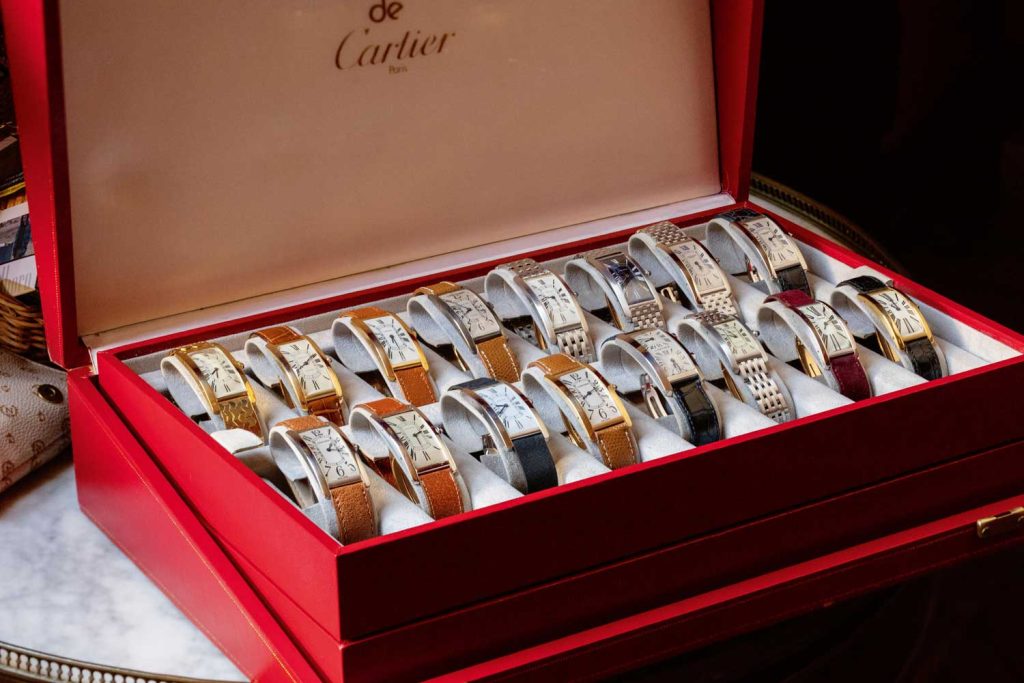
Some of Auro Montanari’s Tank Cintrées, in a Cartier box, showing the evolution of the watch line (©Revolution)
Last year, I had the opportunity to make a piece unique with Cartier and it was a total team play, which is you know, I didn’t realise at the time that Auro [Montanari] clearly shares a passion for that particular model. When I showed it to him, he said something like ‘Oh, do you like Cartier?’ and he sent me a picture of this and I literally fell off my chair. It’s one of the most staggering collections, as you would expect from the awesome dude, and the amazing fount of knowledge that is Mr. Goldberger. So I think we should start with the Tank Cintrée. You share a passion for this model as well.
I fell in love with the Cintrée the first year I saw the model in ’78 in a flea market in New York, it’s the famous flea market on 26th and Sixth Avenue. I saw a nice example in the display of a dealer and it was an incredible piece but it was a problem because they asked for US$4,000 and I didn’t have $4,000 in my pocket. After that in ’82 I found the first Cintrée in my collection which was made in 1929. I found it in a flea market in Arezzo, a very popular city for antiquities south of Florence and I went there with my parents because they were great art collectors and I found this first Cintrée of my collection and I paid around €3,000 for it. It’s the first series of the Cintrée with brancards, with a movement by the European Watch and Clock Company inside with the original dial with the Roman numerals and with ‘Cartier France’ printed on it.
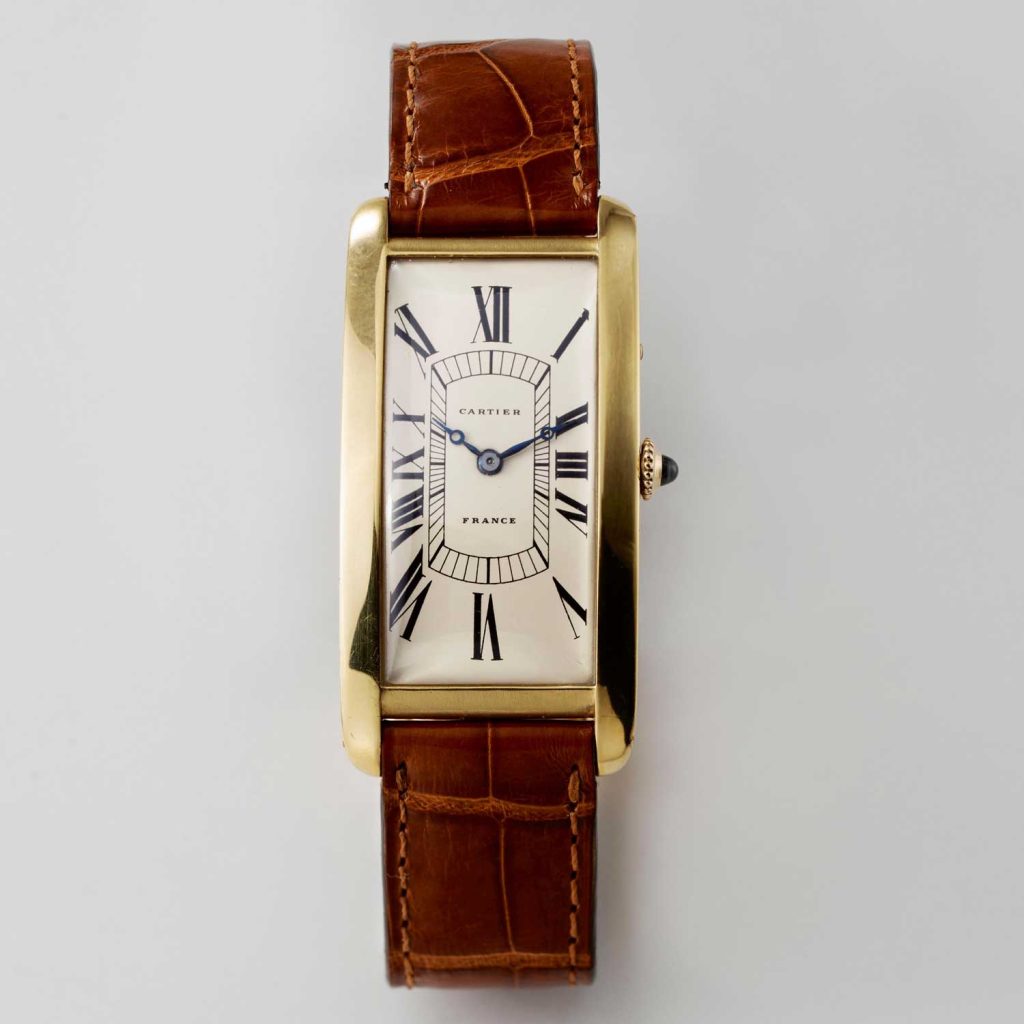
The first Tank Cintrée that Auro Montanari acquired, which led to the development of a lifelong passion for collection Cartier watches (Image © Revolution)
It must be a very emotional piece for you because this is the one that started you on this journey.
Yeah, I love the size, the lines. It’s a time-only watch and you can wear it on a daily basis and I think it’s a very contemporary look. You know, Cartier designed the first Cintrée in 1921. Imagine making a watch like this, because in the same period other companies made this kind of big curves. Patek Philippe with the Gondolo and others like Tissot and Omega, they made big curved cases in silver. But that’s another story. Those had great movements inside, great dials and construction with a screwed-in case.
You were saying that the cases from this period are thinner.
Thinner yes, and covered, you see that.
And more pronounced in terms of their curvature.
You see it also on the sapphire cabochon of the crown. Many are with Roman numerals and also with the Breguet hands. In the same period there’s very rare Cintrée made in silver. It was a special order for the customer and you feel the oxidised case and also the dial is very interesting because they explored Arabic numerals.
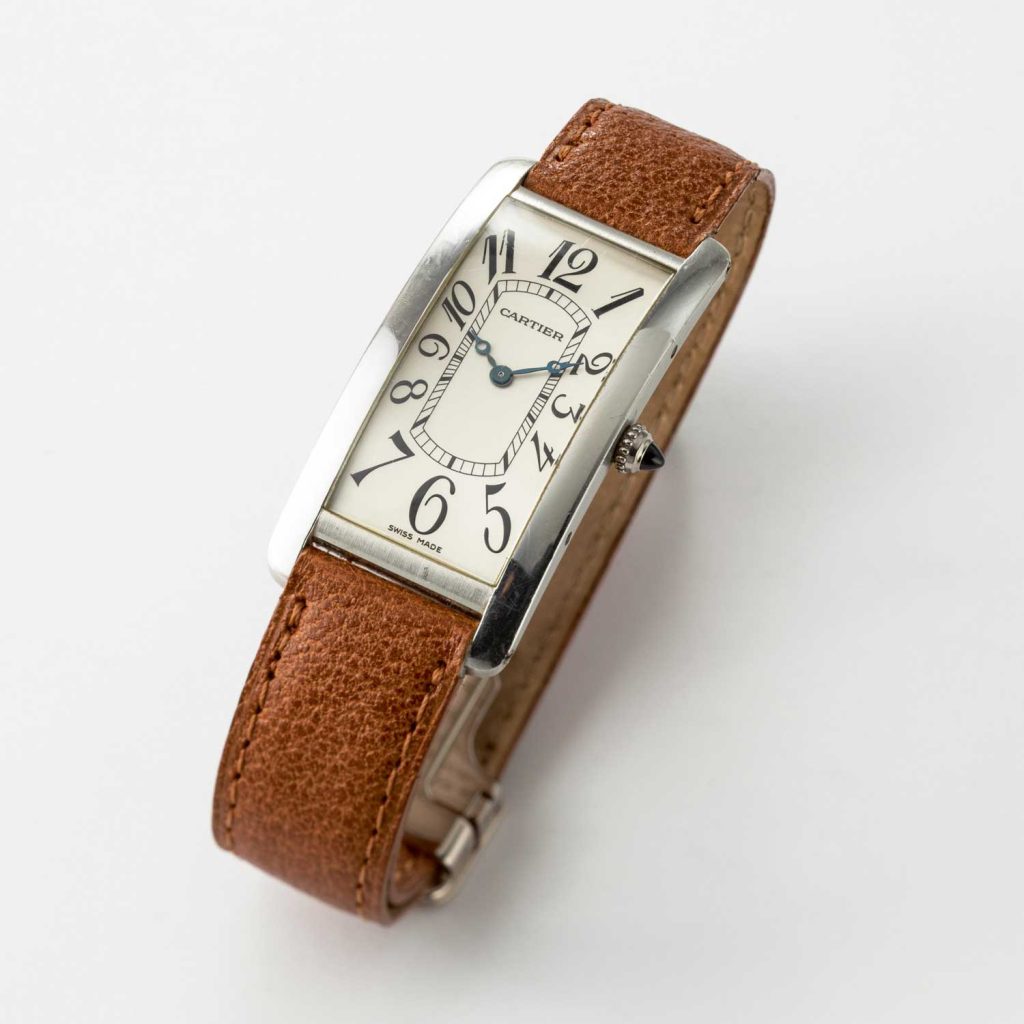
Ref. 2843, produced from 1998 to 2009 under the Collection Privée. This model from 2004 has the ‘Swiss Made’ label on the dial, Arabic numerals and Breguet hands with a pointed crown and a screw-down back for water resistance (Image © Revolution)
What a stunning watch, with the blued Breguet hands as well. I can see what you’re saying about the construction of the case because when I look at this compared to my modern watch, this is much thinner.
Yes, I have the modern one, this is a special order made 15 years ago in Paris, and the dial has blue numerals. You see that the case is thicker.
Wow. I take it this is a platinum watch, with a platinum bracelet from Cartier as well?
Yes.
Extraordinary. And what year is it from?
It’s from around 12 years ago.

Auro Montanari pictured at home, wearing a special order Tank Cintrée with a platinum case and bracelet on his wrist (Image © Revolution)
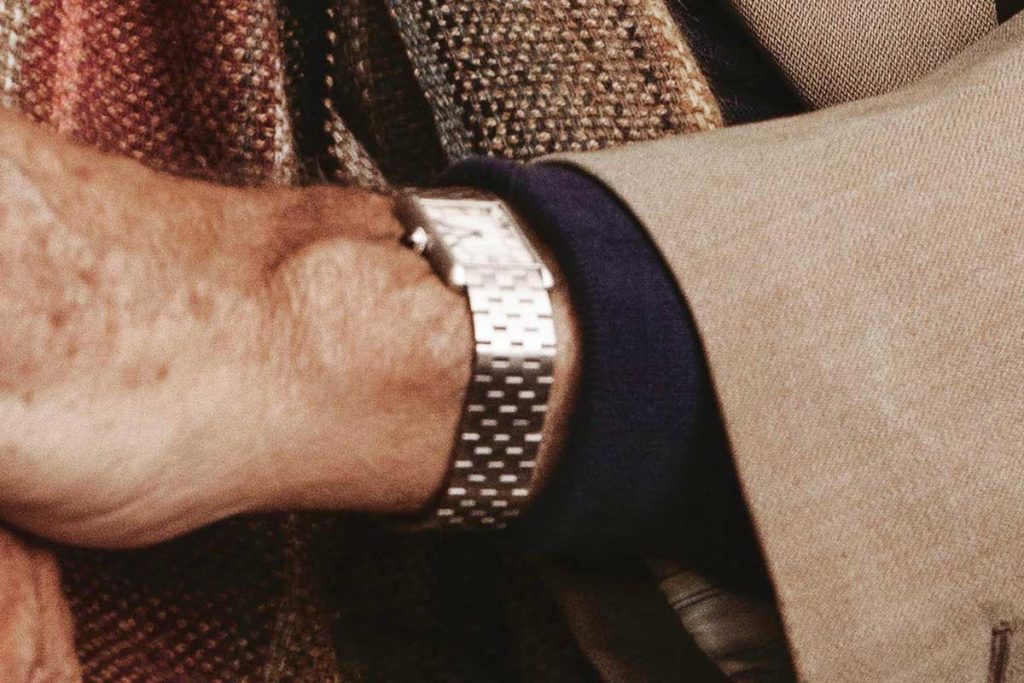
Auro Montanari pictured at home, wearing a special order Tank Cintrée with a platinum case and bracelet on his wrist (Image © Revolution)
If you look at these two cases side by side you can see there’s a pronounced difference in terms of the architecture. Truly stunning. So tell me what did you acquire after your first Tank Cintrée. Where did the journey take you?
Time after time, the journey during my life of collecting watches brought me back to Cartier, and I bought many different cases from them. I have a big passion for the Cartiers made in London, because London was different from Paris, especially between 1966 and 1974. They had a special line for their special customers in London during this time and you can see that the construction of the case is a little different. The movement within was always LeCoultre with a number engraved on the back as well as on the buckle.
You know our dear friend Nick Foulkes, he loves this period of Cartier in particular. It’s interesting how there were basically three Cartiers at one point—Cartier New York, Cartier London and Cartier Paris because of the three Cartier brothers.
Yeah, the brothers each managed a branch. In London it was Jacques Cartier, and in all the cases made in London there is always a JC poinçon, his initials. The design of the dial is different because there is no chemin-de-fer. The numerals are elongated and the signature is cursive, instead of the classic fonts from Paris.
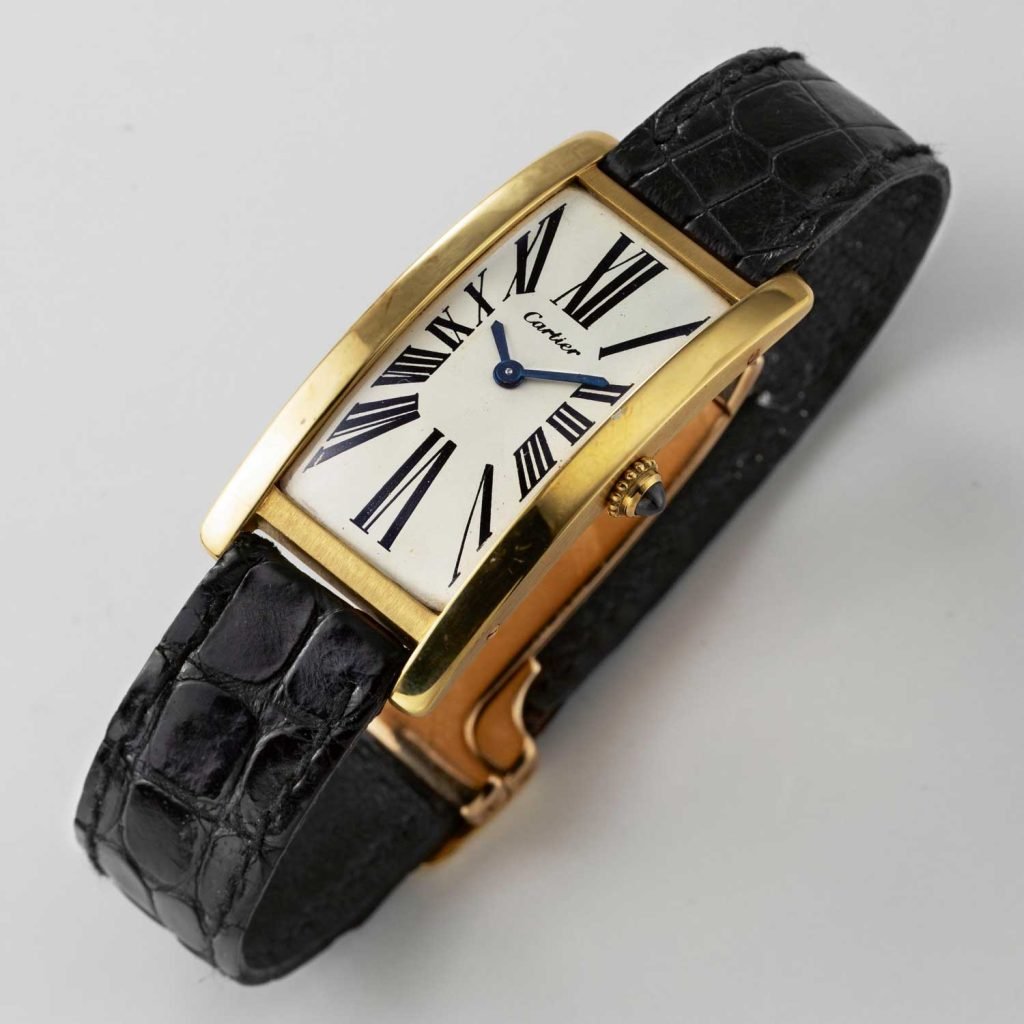
Cartier Tank Cintrée made in London ... (Image © Revolution)
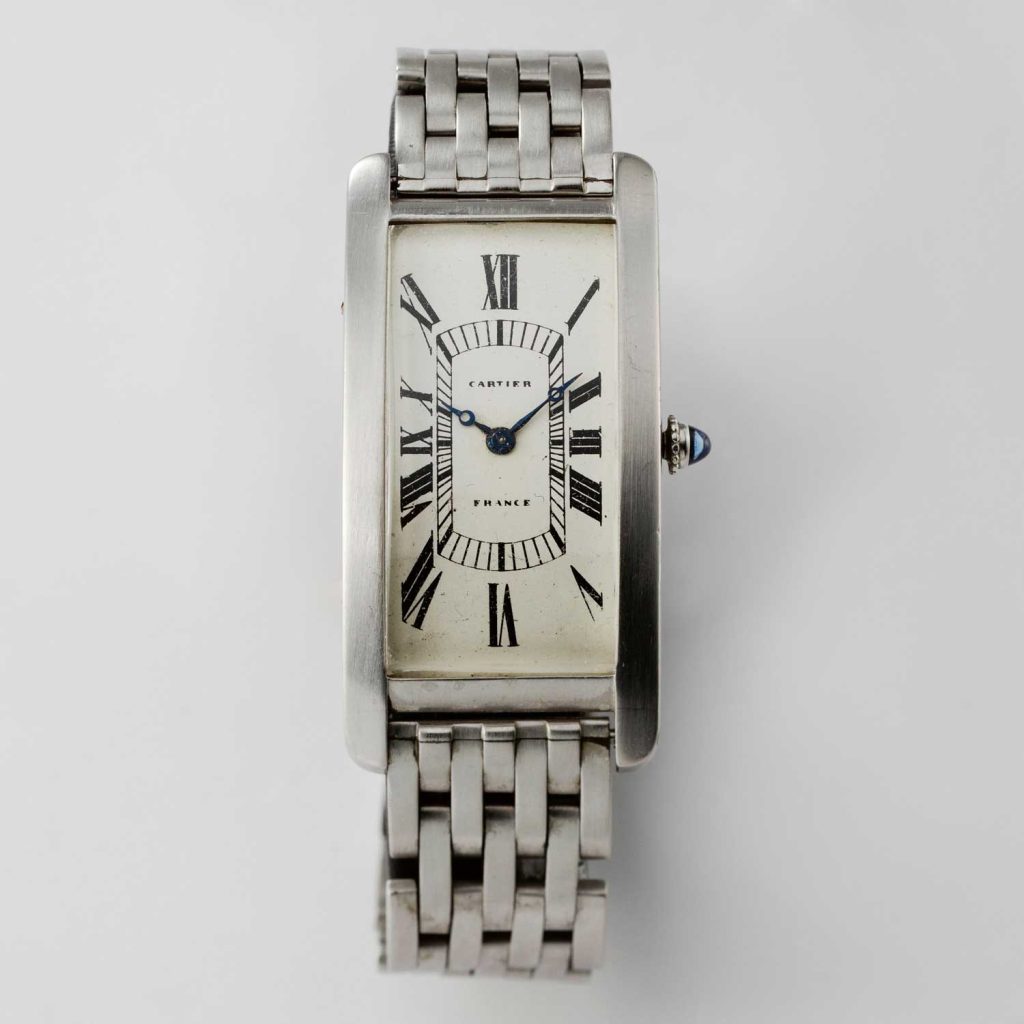
...compared with a Cartier France edition. Notice the differences in the lack of a chemin-de-fer in the London edition, as well as elongated numerals (Image © Revolution)
You know, for a watch that was initially designed in 1921, to see it extrapolated in this version that in some ways, really captures all the design spirit and the energy of the ’60s in London which was the most exciting time to be in the world for that city.
London in that period was the center of the world, for fashion or for cars, movies and designers.
Now were you saying that there were multiple sizes of Cartier London Tank Cintrées?
There were three sizes: small, medium and large. And Cartier Paris made two different sizes there: a large model with a nine-ligne movement, and the small or medium size with the seven-ligne movement. These are from the same period, in the ’30s, with the same construction as the rest, you see.
Now if I’m not mistaken, this watch is particularly interesting because there are two examples of it.
Yeah, the last one was sold by Phillips a few years ago. They have the same kind of dial and case, the only difference was the cursive signature. One was sold in New York, the other in Paris.
That was sold during the same auction when they sold Paul Newman’s Paul Newman Daytona. That was also quite a hot lot. Now tell us what makes us this watch so unique.
It’s unique because of its condition. The original dial, still crisp decades on, with original parts especially this bracelet is amazing. Look at the construction of the seven-link bracelet and the closing
of the buckle.
This is another very interesting watch as well. Tell us a little bit about this one.
This was made in the ’50s. See the the case, it’s a little thicker, compared with the last one from the ’90s but it has a very special bracelet. You see, in the ’50s they started to change the crown. They began to make the octagonal crown with the sapphire cabochon.
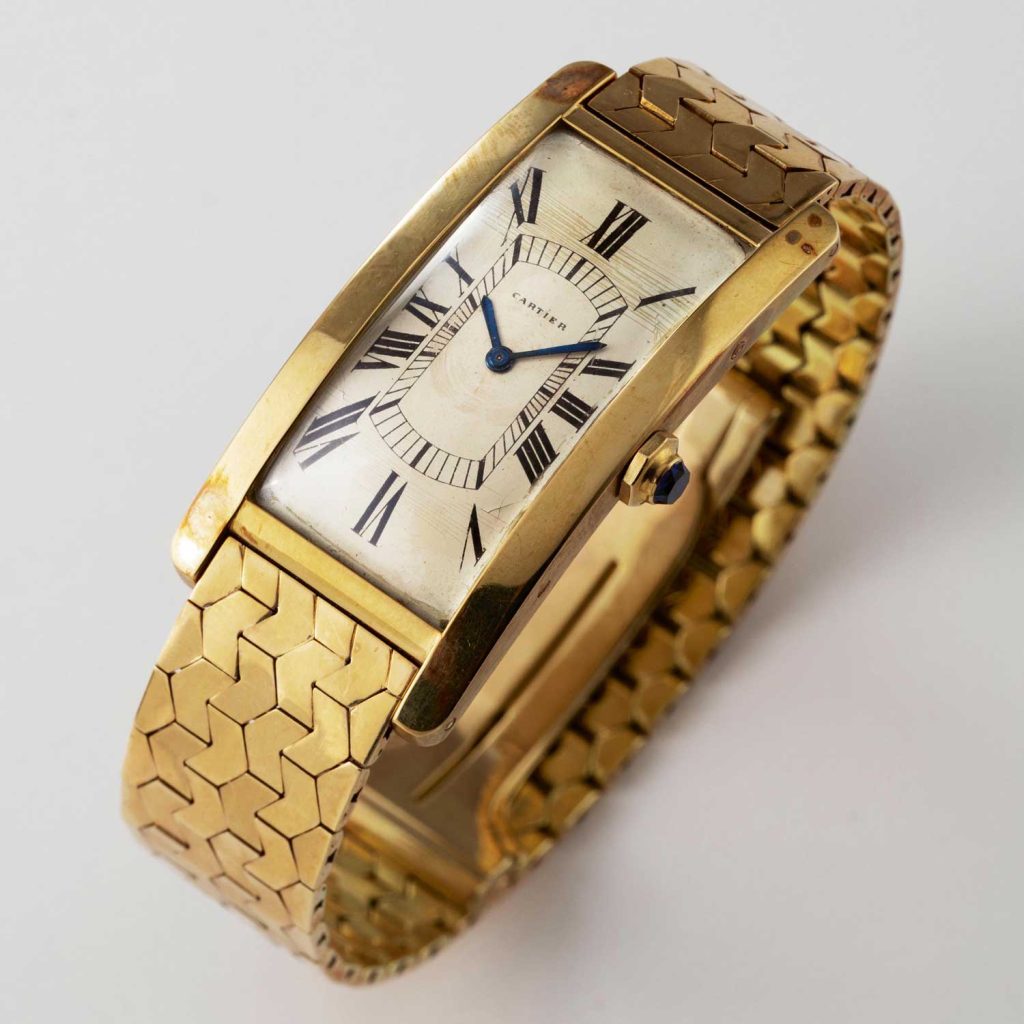
Yellow gold Tank Cintrée from the 1950s marks a significant Cartier design evolution with the octagonal flat crown and cabochon, from the old pointed crown (Image © Revolution)
What is it about the Cintrée that appeals to you so much?
First of all it has a good heritage. This was designed in 1920/1, almost 100 years ago, but it has a great contemporary look. It’s a simple time-only watch. You can wear it anywhere. It’s so elegant.
It’s absolutely stunning. This bracelet’s amazing as well.
Here’s a rare example from the end of the ’70s in platinum.
This dial is incredible.
Yeah. You can see the difference in the finish of the dials, it’s lacquered. Why lacquered compare with the old one that’s more matte and the case is thicker. Inside is a Jaeger-LeCoultre movement. You can see the evolution of the Cintrée as well in this example, they only had one made for the 1996 Antiquorum auction for Cartier and they made a special dial for the occasion. What’s different from the other examples is the mix of Roman and Arabic numerals. It’s a dual time zone, but using two small movements.
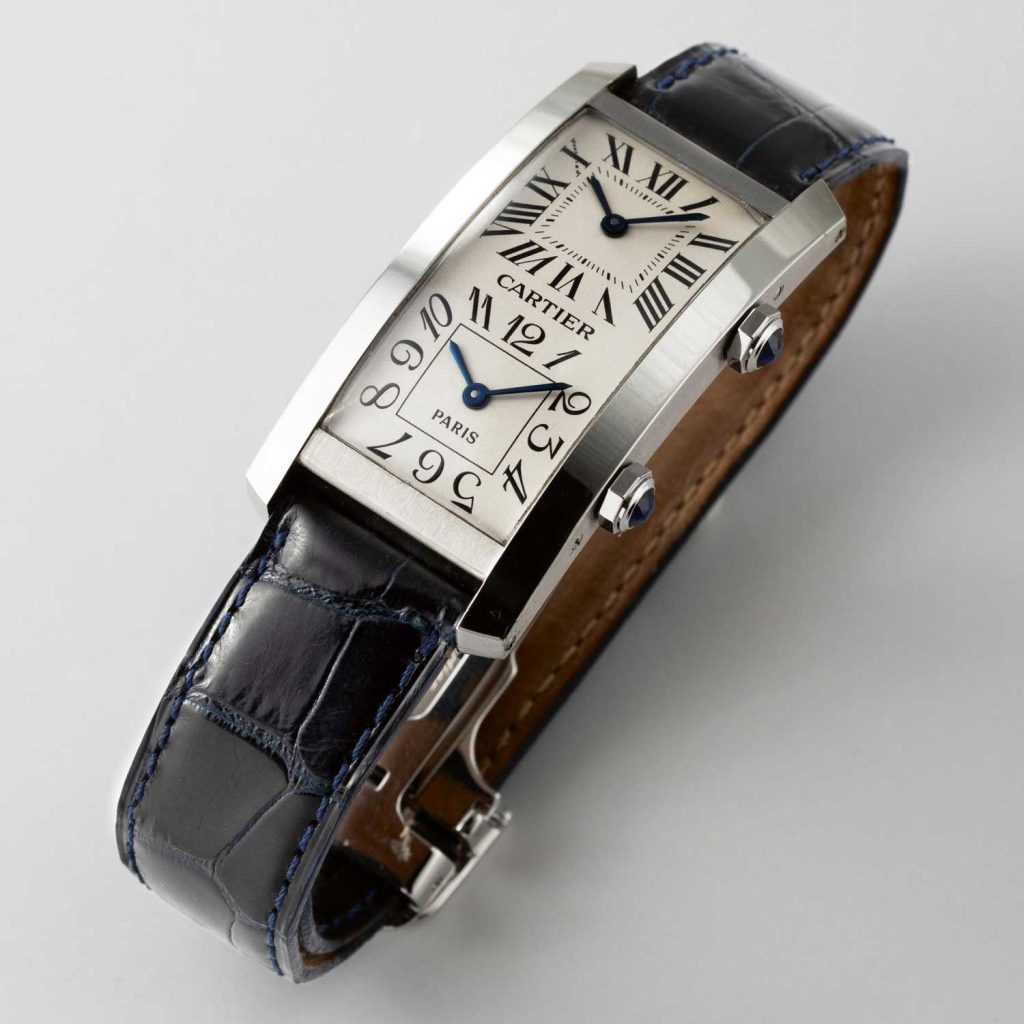
Rare Cartier Tank Cintrée dual time zone watch, driven by two small movements with Arabic and Roman numerals on the two dials (Image © Revolution)
We saw this watch in Franco Cologni’s book as well. Now the Antiquorum auction was quite interesting as a period of history for Cartier. I think you’ve got another watch that was created for that auction.
Yes, it’s a Tank à Guichet and they made three examples in platinum. I had an old platinum bracelet by Cartier from the ’50s and they made three examples all numbered on the back and this is number 3 of 3. The difference between this and the other 150 made for the regular production is that the crown is on 12 instead of six. It’s a Piguet movement, a great movement.
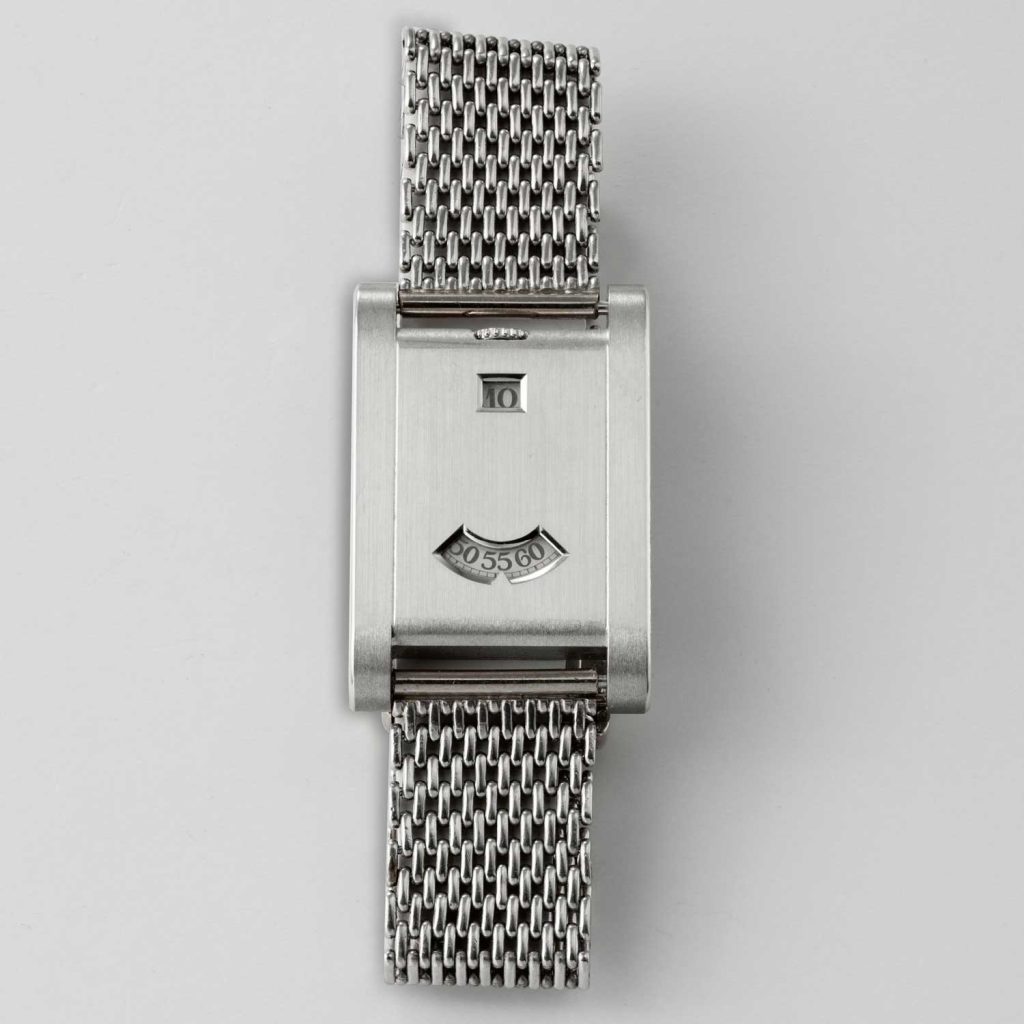
The Tank à Guichet was the first jump hour timepiece by Cartier in 1928. This special edition, with a crown at 12 o’clock rather than 6, was created for the 1996 Antiquorum auction in platinum (Image © Revolution)
I love how well the crown is also integrated into the case despite being at 12 o’clock.
No use at all [referring to the crown] and also very difficult to read the hour without eye-glasses.
Yeah it’s impossible for me to read. The irony is when you finally can afford some cool watches, that’s when you can no longer read anything on those. [laughs] What else do you have in the other box there that you are excited about?
Here I have simple Tanks like the classic Tank in platinum with an original platinum bracelet from 1929. It’s very rare to find one with an original dial, crown and other parts.
Do you consider Cartier to be something that still has potential as an investment because it strikes me that there are certain references that are collected but there are also some references that no one really knows and are quite rare.
The problem is in knowledge on Cartier because compared to other brands that are collected like Rolex, Longines, Omega and Patek Philippe, you have access to a lot more information on the Internet, on blogs and even in the catalogues. For Cartier it’s a lot harder to find and also there are so many fakes in the market. For Cartier you need to open the watch to check the movement, the seals and the provenance. It’s hard.
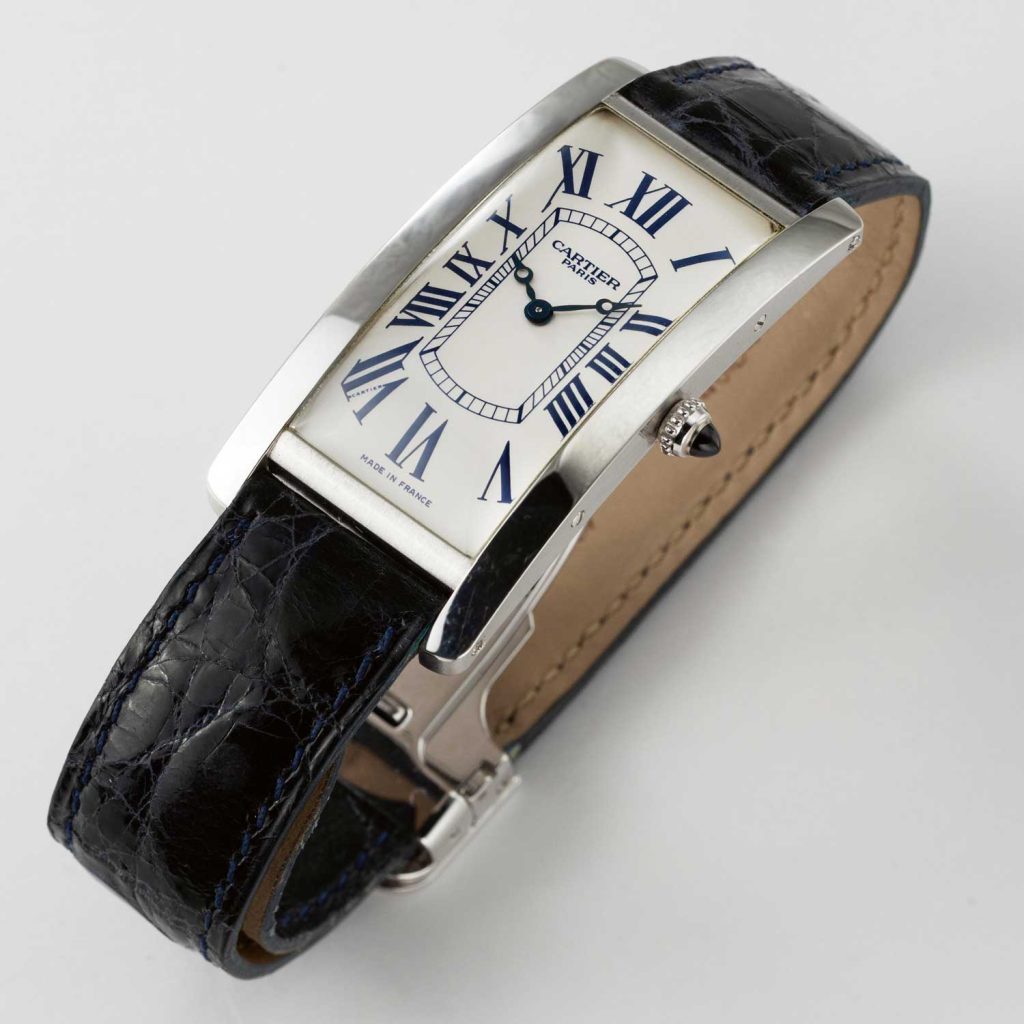
This edition from 2005 brings together a special order Tank Cintrée, indicated by the ‘Made in France’ script on the dial, and the Breguet hands which have given way to sword hands today (Image © Revolution)
I want to tell you a story, but you can tell me whether you think it’s true or not. I heard this quite famous story about how two of the most famous independent watchmakers of all time, they somehow got a hold of one of the books from Cartier that detail all the models and the history and the complications and the specifications. And then these two independent watchmakers who are now two rock stars they made some of those watches.
Yeah. It’s a famous rumour, and they made great watches. I saw a few examples, perfectly made, with matching numbers. This was the beginning of the ’90s, and for two or three years I saw a few on the market, made in the best way.
Incredible. And considering how famous those two watchmakers are today, I would actually imagine those watches could be considered collectible.
Maybe. [laughs]
Now if we go back to the Tank Cintrée…
Here’s another interesting Cintrée, the medium size from the ’30s, all platinum with a special bracelet as well and a yellow gold case back. It has a special screw to pull the crown out.
Fantastic. It’s interesting to see how this watch can be extrapolated in three different sizes as well. And regardless of which size, it doesn’t lose its character at all. I mean, this is quite a smaller watch and I love the fact that it’s on a bracelet, which brings a little bit more sort of substance to it. But still equally stunning, you know.
Yeah, I think that the elegance of the [watch on] the wrist is incredible.
And on what occasion would you wear this watch?
I never wore this kind of watch. [laughs] Because it doesn’t keep very good time. And you have to be very careful about it because the case is square and there are screws [for the brancards]. I wear just the modern one.
Speaking of the modern one, you’ve got one with blue numerals.
Yeah, it was a special order for a good friend of mine. This was done in Paris, whereas the other ones are made in Switzerland. It’s number three of three. And it was a special order for the collector. And he asked especially for the blue Roman numerals and Breguet hands.
So comparing the pieces you have, from the ’50s there’s a much more substantial case and now instead of the cabochon set on the sort of pointed crown, you now have an octagonal crown that’s flat.
And at the end of the ’60s there is another rare white gold model but we’ll jump to the end of the ’70s when they made this thicker case. Now here’s a mid-90s model, a special order and another for regular production in yellow gold. They were produced in France, but I can’t remember how many pieces were produced. After that, they began to produce the platinum models in Switzerland, the difference was that the screws were on the back because they were trying to make it waterproof.
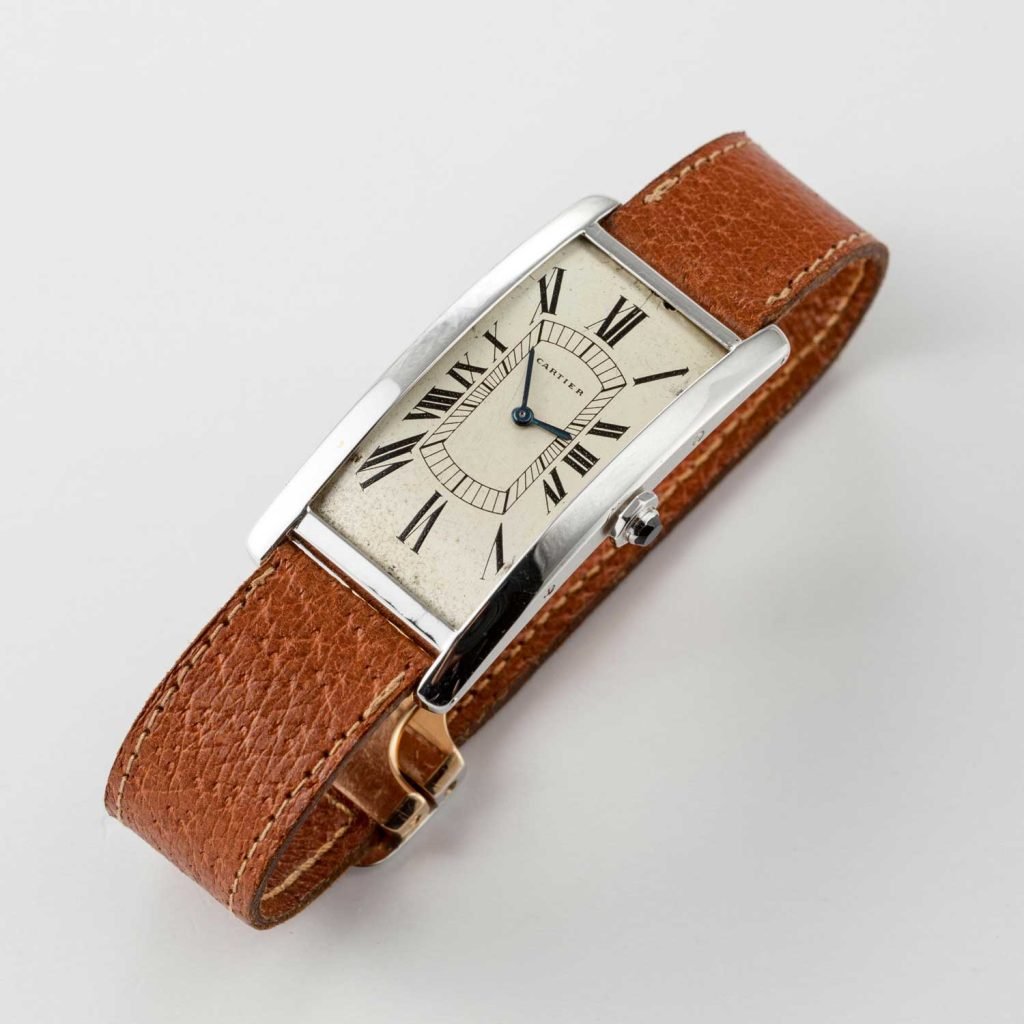
Rare white gold Tank Cintrée from the ’60s, with a more streamlined profile and the octagonal crown and cabochon (Image © Revolution)
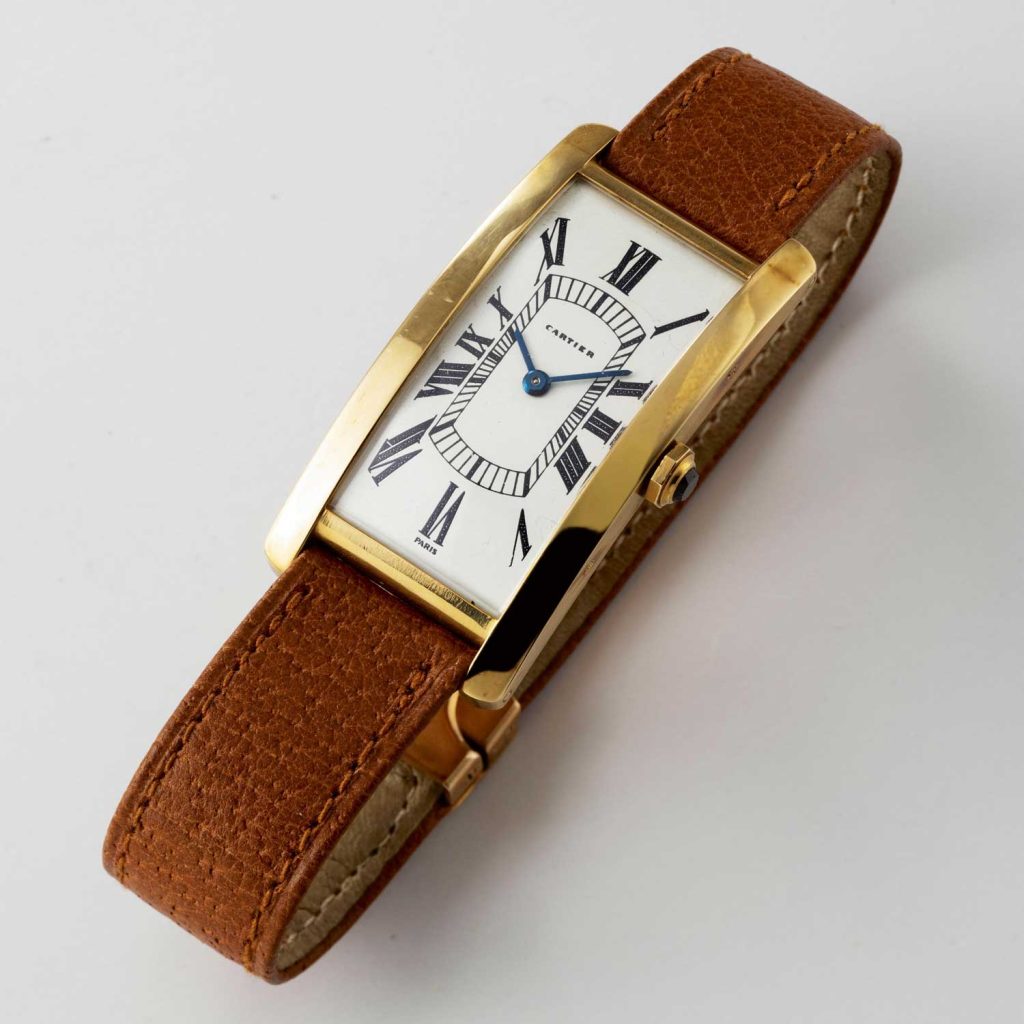
A 1970s Tank Cintrée revives the more substantial case of earlier decades and applies a new octagonal crown. The word ‘Paris’ is printed under the 6 o’clock marker, indicating its atelier of origin (Image © Revolution)
Were they successful with the water resistance?
[laughs] I don’t know. I never tried. Here are the last versions of the watch, it’s with the same size and profile, minus the screws. They showed it during SIHH in Geneva, in pink gold with a black dial, a yellow gold model and in platinum with the metallic Arabic numerals, which I love, with the red cabochon crown.
So, you think Cartier are on the right track today.
Yeah, now they are back to their roots. They also made a good re-design of the Santos. The period between 2000 to 2010 with the large-sized watches, with complication movements. In the past, they never made that many tourbillons… there were a few chronographs by Audemars Piguet but no grand or multi complication watches. Cartier’s heritage is in jewelry watches and elegant watches, refined time-only pieces.
I think though, that was indicative of that entire era. There was so much interest in complicated watches during that period, and I guess Cartier tried to respond to that by integrating high complications, and they had a very talented watchmaker, Carole Forestier as well. But you’re correct. Those watches were out of keeping in terms of the prevailing spirit and continuity of Cartier and today they’re back with creating just beautifully shaped, very stylish watches.
For example, this one complicated model was sold by Cartier in the ’50s, made by Audemars Piguet. It was a square complete calendar with Cartier’s label on the dial. There are very few examples of square Cartier full calendar watches around. There’s another example with the same kind of dial with thicker Roman numerals and that’s it.
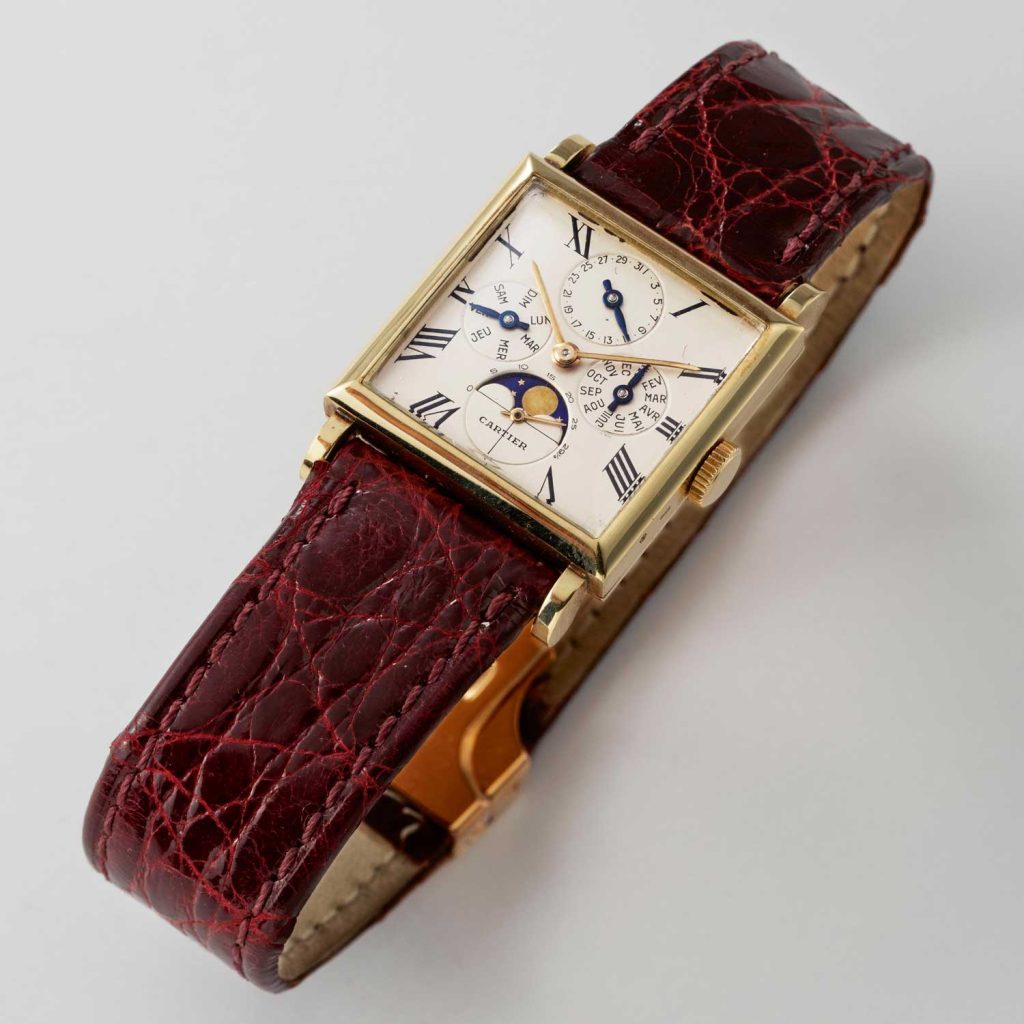
Rare Cartier watch with a complete calendar with movement by Audemars Piguet (Image © Revolution)
Don’t you have also a Cartier watch with an Audemars Piguet jumping hour display?
Yes, they made it in the ’30s and it was manifested by Audemars Piguet. The company was very close to Cartier and they made many watches for the brand. It’s a jumping hour in white gold, with Breguet numerals and Cartier’s logo on the dial. It was sold in New Yorker with a platinum bracelet made in the United States and with a nice inscription the back of the case. Classic Art Deco style.
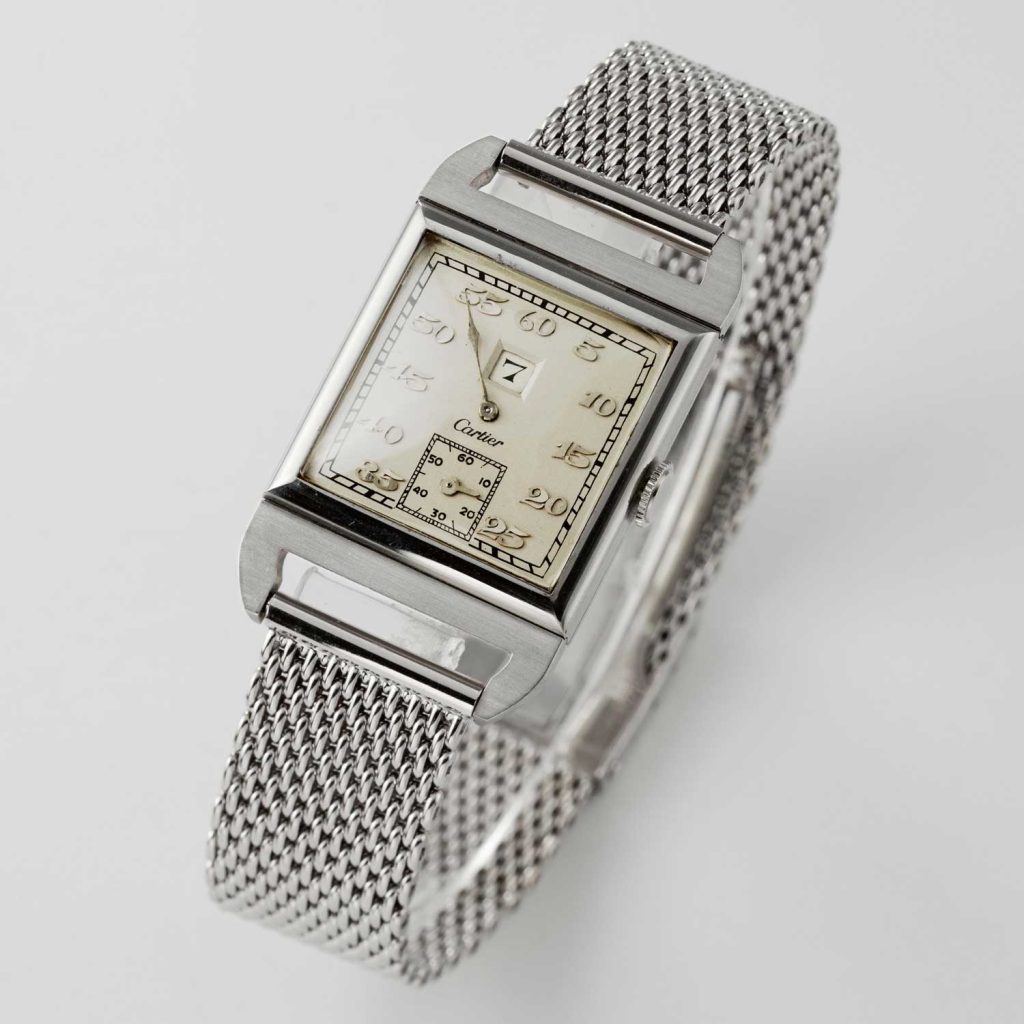
Jump hour display watch with an Audemars Piguet movement from 1929 (Image © Revolution)
You know, one of the watches that Cartier generally shows during SIHH is a vintage Tank Cintrée that was commissioned by Fred Astaire.
I remember, it’s with the same kind of case but with exploded numerals like this with the radium on it.
What do you think of that?
It’s a great watch. The problem is the watch was purchased in auction a long time ago by Cartier with the original Radium numerals and they restored it, because it is very difficult for them to still keep a radium dial in the collection and they did a good job. They made the exploded numerals like the original and they show it in their museum. I think they showed it at the 2018 SIHH in Geneva, because I also remember the nice platinum Crash watch, which came from the Bagnoire Allongé.
The Bagnoire is a very nice watch.
It’s very London. The large one and the medium-sized one originated from London, as did the Crash which came from an Allongé that was destroyed by a customer. And Jacques Cartier had the idea to have Cartier London design this strange watch in 1967 or ’68. They made around 12 to 15 examples. They made a limited production in the ’90s, in yellow gold with a different movement. And then they stopped because the Paris office stopped manufacturing watches with the London name. The new Crash they showed at the 2018 Salon in Geneva was a great watch. But they made a little mistake on the dial.
What was the mistake?
It was the ‘Swiss Made’. It’s not London on the dial, which is very important.
It’s totally inconsistent with the roots of that model. Understood. What is this Cintrée with the blue dial here?
This is a very old Cintrée made in the ’30s. It was purchased from a very important collector in the ’90s, and he’d ordered a special dial for this watch from Paris with the blue nuanced soleil and white Roman numerals.
So this dial was actually created in the’90s.
Yeah, but it’s a good dial.
What are these, incidentally?
Ah yes, the Helm. It’s a special design made in the ’50s by Cartier, like a wheel or ‘helm.’ And they made it in yellow gold with a special bracelet with a European Watch and Clock Company movement. This isn’t the original crown, unfortunately.
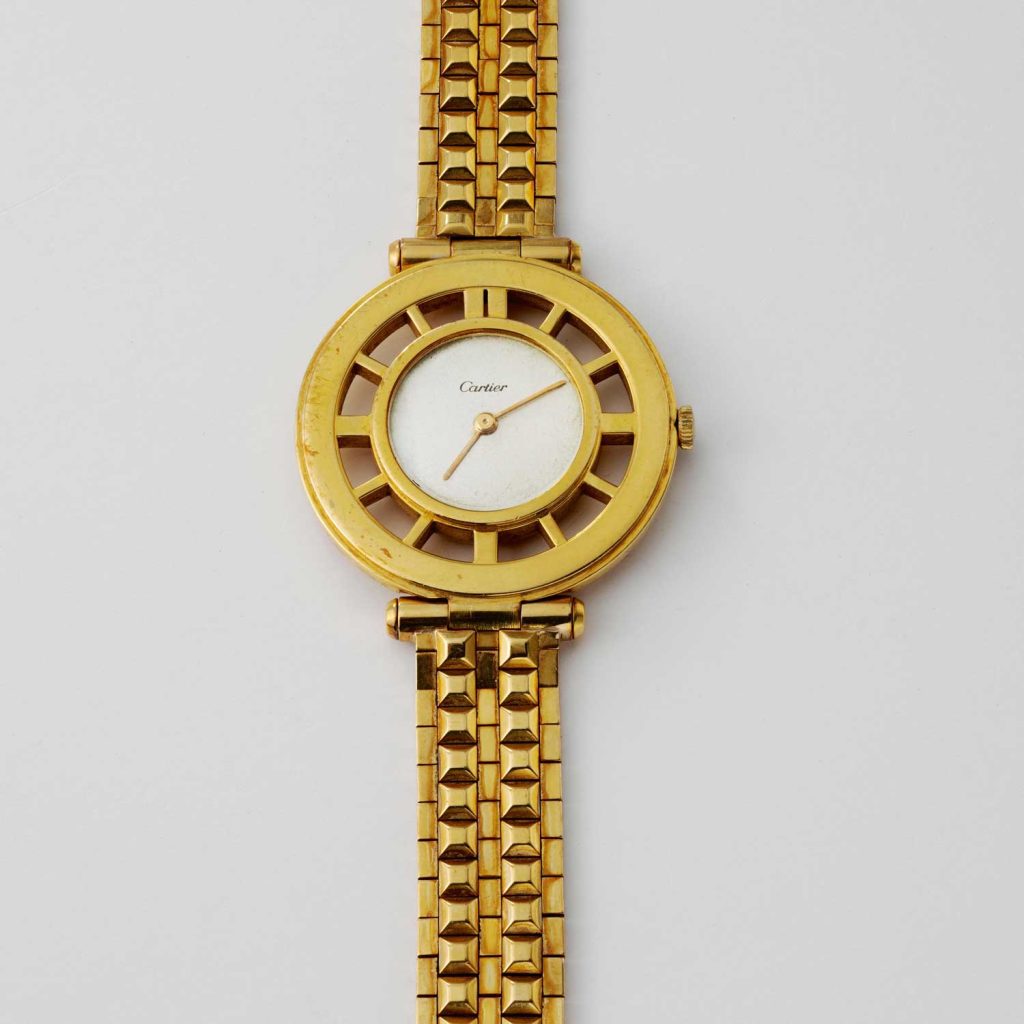
Helm watch in yellow gold, made during the 1940s and 1950s (Image © Revolution)
It’s a cool design.
That’s another Helm in platinum with round indexes.
I love the fact that essentially as an optical illusion, this is a tiny movement and the crown goes through one of the pillars.
This is nice because the crown is on the back. It’s a Duoplan, a Jaeger-LeCoultre ébauche. Mine was manufactured by the European Watch and Clock Company because at the end of the ’20s, before 1930, Edmond Jaeger and Cartier set up a company, which continued until the ’60s. After that, they used a Jaeger-LeCoultre movement, and then they changed to quartz. And now back to a good movement. There was a period from the end of the ’70s to the beginning of the ’80s, when they used a lot of ETA movements inside.
Now if you were trying to advise someone who would be interested to purchase their first vintage Cintrée or first vintage Cartier Tank, where would you tell them to look?
You have to trust the dealer, it’s the only way. You can spend a lot of time to learn about vintage Cartiers. But it takes a lot of effort.










